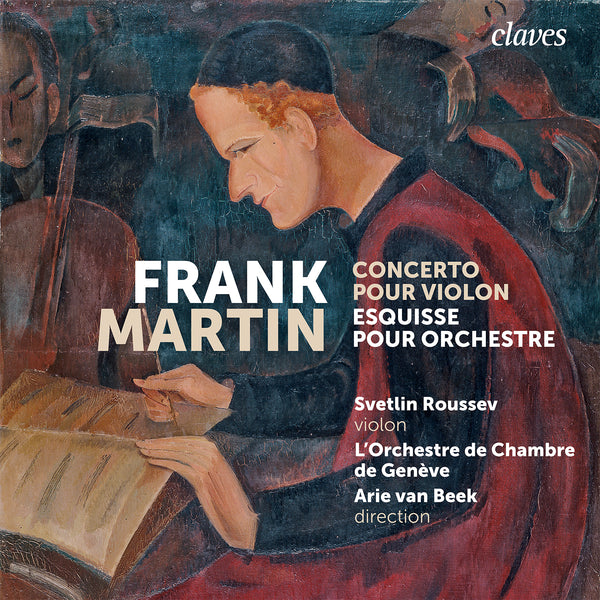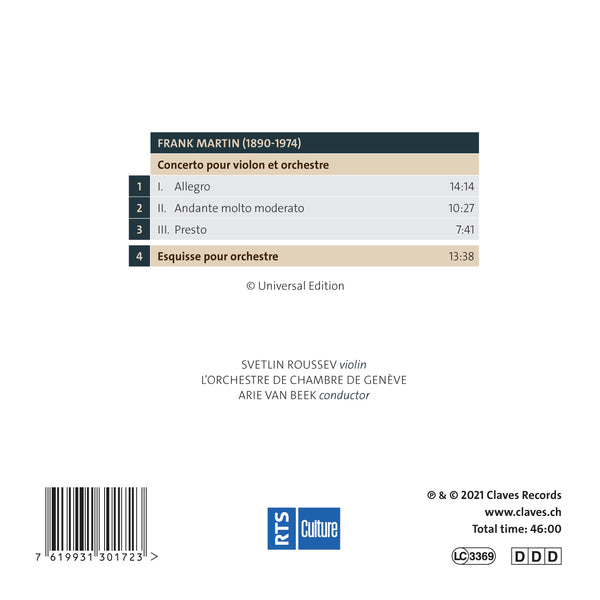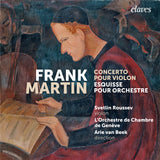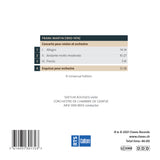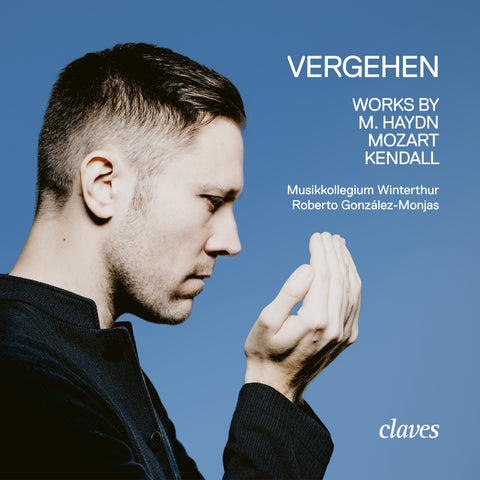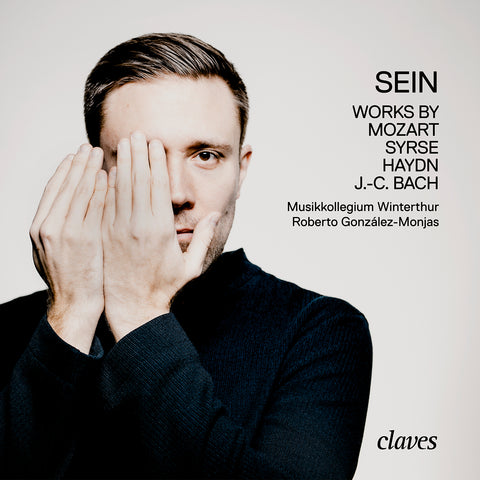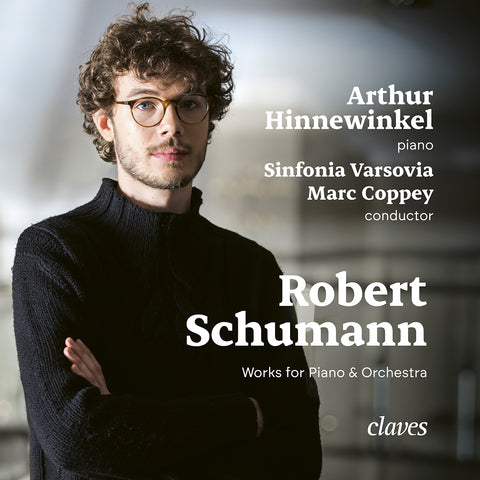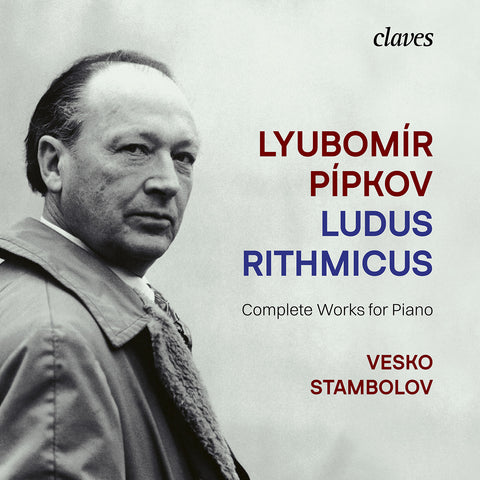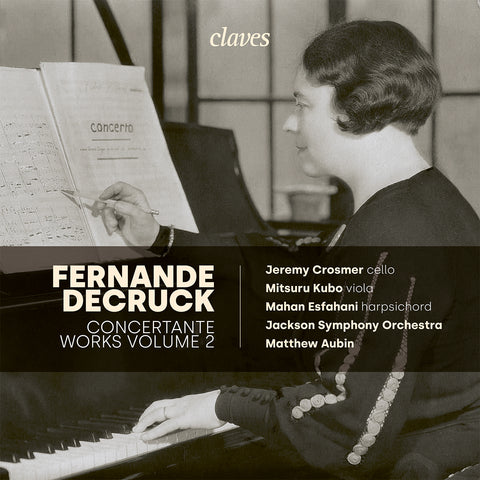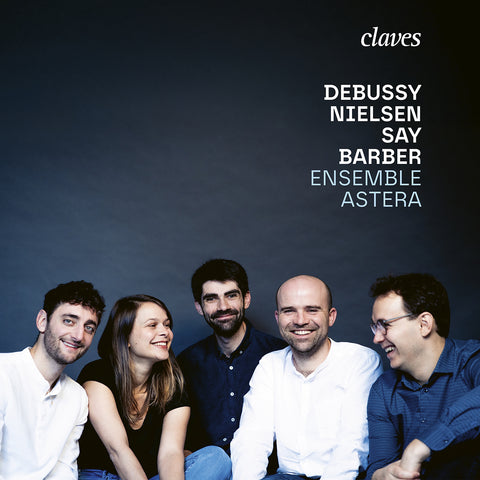(2021) Frank Martin : Concerto pour violon, Esquisse
Kategorie(n): Concerto Orchester Raritäten
Instrument(e): Geige
Hauptkomponist: Frank Martin
Orchester: L'Orchestre de Chambre de Genève
Dirigent: Arie van Beek
CD-Set: 1
Katalog Nr.:
CD 3017
Freigabe: 04.06.2021
EAN/UPC: 7619931301723
Dieses Album ist jetzt neu aufgelegt worden. Bestellen Sie es jetzt zum Sonderpreis vor.
CHF 18.50
Dieses Album ist nicht mehr auf CD erhältlich.
Dieses Album ist noch nicht veröffentlicht worden. Bestellen Sie es jetzt vor.
CHF 18.50
Dieses Album ist nicht mehr auf CD erhältlich.
CHF 18.50
Inklusive MwSt. für die Schweiz und die EU
Kostenloser Versand
Dieses Album ist nicht mehr auf CD erhältlich.
Inklusive MwSt. für die Schweiz und die EU
Kostenloser Versand
Dieses Album ist jetzt neu aufgelegt worden. Bestellen Sie es jetzt zum Sonderpreis vor.
CHF 18.50
Dieses Album ist nicht mehr auf CD erhältlich.
This album has not been released yet.
Pre-order it at a special price now.
CHF 18.50
Dieses Album ist nicht mehr auf CD erhältlich.
CHF 18.50
Dieses Album ist nicht mehr auf CD erhältlich.
SPOTIFY
(Verbinden Sie sich mit Ihrem Konto und aktualisieren die Seite, um das komplette Album zu hören)
FRANK MARTIN : CONCERTO POUR VIOLON, ESQUISSE
FRANK MARTIN (1890-1974): VIOLINKONZERT (1950-1951) UND ESQUISSE FÜR ORCHESTER (1920)
Berg und Meer
„Freier Mensch, du wirst das Meer immer lieben!“ Selbst der in Genf geborene Frank Martin (1890-1974), der als junger Mann die schroffen Pfade der Schweizer Alpen entlangwanderte und sich im Klettern versuchte, hat den Dichter Baudelaire nicht Lügen gestraft! Die unendlichen Horizonte des Meeres wurden für Frank Martin allmählich zu einem zwingenden Bedürfnis, das er mit 56 Jahren befriedigte. Er ließ sich dann in Holland nieder, dem Land seiner dritten Frau Maria Boecke (1915-2017). Bei langen Strandspaziergängen, bei denen er sich wieder mit dem Gefühl stiller Fülle verband, das er bereits auf hohen Gipfeln erlebt hatte, kam Frank Martin zu der Überzeugung, dass „die Berge statisch sind, während das Meer Bewegung, Rhythmus und unbegrenzte Weite hat“.
Es ist nicht auszuschließen, dass diese Anziehungskraft des Meeres und Frank Martins Interesse an William Shakespeares „Der Sturm“ miteinander in Verbindung stehen. In diesem Drama spielen die Wellen und die Turbulenzen, die sie verursachen, wenn sie ihre Kraft entfesseln, eine entscheidende Rolle.
Ariels Geist
Mehrfach schrieb Frank Martin, dass ihn Shakespeares „Der Sturm“ über Jahre hinweg „verfolgt“ habe (siehe die Kommentare zu seinen eigenen Werken in „Kommentare von Frank Martin zu seinen Werken“, veröffentlicht von La Baconnière, Neuchâtel, 1984). Er war fasziniert von der Vielfalt der Charaktere des Stücks und der ständigen Präsenz des Meeres mit seinem unveränderlichen Rhythmus. Frank Martin setzte seine Faszination für Shakespeares Stück erstmals in Cinq chants d'Ariel um. Diesem 1950 komponierten Stück für gemischten Chor folgte die Oper Der Sturm, die 1955 an der Wiener Oper uraufgeführt wurde. Der Kontext von „Shakespeares Tempest“ beeinflusste auch ganz natürlich Frank Martins andere Kompositionen dieser Zeit, insbesondere das Violinkonzert.
Dieses von der Stiftung Pro Helvetia in Auftrag gegebene Werk wurde 1950-1951 anlässlich des 25-jährigen Bestehens des von Paul Sacher gegründeten Kammerorchesters Basel komponiert. Frank Martin begann mit der Niederschrift des Werks, das „von der märchenhaften Atmosphäre durchdrungen ist“, in die Ariel gehüllt ist. Der Luftgeist ist an Prospero, den Herzog von Mailand und Magier, gebunden, der die Naturelemente durch sein Wissen beherrscht. In diesem Konzert hat Frank Martin die Rolle, die dieser Art von Komposition zugewiesen wird, voll und ganz respektiert: „Ich habe mich in der Tat bemüht, so weit wie möglich ein echtes Konzert in drei verschiedenen Teilen zu schreiben – Allegro-Andante-Presto –, das ein symphonisches Stück ist, aber von einem Soloinstrument geleitet und angetrieben wird. Es zielt auch darauf ab, die Qualitäten des Instruments und die des Spielers zu zeigen (op. cit.). Ariel taucht mehrmals auf oder zeigt seine Flügelspitzen, „geheimnisvoll weit entfernt, am Ende des ersten Satzes oder beim Einsatz der Violine im zweiten Satz, oder lebhaft und verspielt, wie zu Beginn des Finales. Doch hier gibt es nichts Geplantes: Ich war einfach ein wenig verzaubert vom Charme von Prosperos Insel geblieben“ (ebd.).
Der Zauber wirkt bereits in den ersten Takten des Werks, Allegro tranquillo. Die durchsichtigen Klänge bereiten den Auftritt des Solisten vor, der einen intensiven lyrischen Gesang anstimmt, gefolgt von einer leidenschaftlicheren Episode. Die Entwicklung ist von dieser Dialektik zwischen Leidenschaft und Spiritualität durchdrungen. Der Dialog gipfelt in einem schillernden orchestralen Kommentar, der an das Spiel der Wellen erinnert. Der Klangfluss beruhigt sich, und der Solist kann sich dann, allein und mit großartigem Ausdruck, gehen lassen, bevor er in eine brillante Kadenz übergeht. Solist und Orchester treffen in der Coda aufeinander, einem Moment voller Spiritualität und Geheimnis, wie es auch der Beginn des Werkes war: Ariel, der Geist, ist nie weit entfernt. Zu Beginn und am Ende des zweiten Teils, Andante molto moderato, herrscht Ruhe. Eine sanfte, wellenartige Bewegung setzt ein, ein zartes Schwingen, bei dem Orchester und Solist eine überaus lyrische Stimmung teilen.
Das Orchester scheint dann seine dramatische, fast furchterregende Aussage durchsetzen zu wollen. In den letzten Takten jedoch führt die Solovioline zu Kontemplation, schwebend auf einem Murmeln tiefer Streicher. Das abschließende Presto ist ein Meisterwerk der Instrumentierung, eine Zusammenstellung von Farben, in der Art der Marinemalerei aus dem Goldenen Zeitalter der Niederlande. Sowohl der Solist als auch das Orchester zeigen tosende Energie. Die Blechbläser und die Pauken betonen bestimmte Merkmale. Es ist ein Spiel zwischen Luft und Wasser, zwischen Geist und Materie, das in einem blendenden Licht endet.
Frank Martins Violinkonzert wurde am 24. Januar 1952 in Basel vom Geiger Hansheinz Schneeberger und dem Basler Kammerorchester unter der Leitung von Paul Sacher uraufgeführt. Dieser große Kunstmäzen verdoppelte das von der Pro-Helvetia-Stiftung versprochene Honorar: ein Angebot, das man nicht ablehnen konnte!
Rückblick
In Frank Martins Jugend war das Genfer Musikleben stark auf die deutsche Musik ausgerichtet, und es wurden hauptsächlich Werke der großen deutschen Meister gespielt. Obwohl Frank Martin, der von Natur aus musikalisch begabt war, nicht dem offiziellen Lehrplan folgte, nahm er ab 1917 Privatunterricht bei Joseph Lauber (1864-1952), einem am Zürcher Konservatorium ausgebildeten Musiker. Lauber war nicht gleichgültig gegenüber den Neuerungen, die französische Komponisten zu Beginn des 20. Jahrhunderts einführten. Er machte seinen Schüler mit den Werken von César Franck (zugegebenermaßen ein Belgier!) bekannt.
Für Frank Martin, der bereits 25 Jahre alt war und mehrere Stücke komponiert hatte, war dies eine Offenbarung. Ebenso wie die Entdeckung der Musik von Debussy, Ravel, Duparc, Fauré und nicht zu vergessen Strawinsky, den Ernest Ansermet – Gründer des Orchestre de la Suisse Romande im Jahr 1918 – regelmäßig in seine Programme aufnahm. Frank Martin war von diesen harmonischen und rhythmischen Neuerungen verwirrt. Seine Suche nach einem höchst persönlichen Stil und einer eigenen Sprache dauerte etwa 20 Jahre, bis er Anfang der 1940er Jahre Le Vin herbé komponierte. Laut Martin selbst war dieses weltliche Oratorium „das erste bedeutende Werk, in dem ich meine eigene Sprache sprach“. Diese zwei Jahrzehnte waren jedoch von Werken geprägt, die alle, in unterschiedlichem Maße, viele der ursprünglichen Merkmale des Komponisten offenbarten. Einige waren nur bescheidene Stücke wie Pavane couleur du temps (1920), andere ehrgeizigere Werke wie La Nique à Satan (1931) oder die Symphonie pour grand orchestre (1934).
Esquisse
In diesem Zusammenhang ist die 1920 komponierte und am 30. Oktober desselben Jahres von Ernest Ansermet mit dem Orchestre de la Suisse Romande uraufgeführte „Esquisse“ für Orchester von besonderem Interesse. Das Stück wurde zu einer Zeit geschrieben, als sich der Komponist von den deutschen Postromantikern verabschiedete, aber noch nicht tiefer in das Studium der Rhythmen eingetaucht war (erst 1926 absolvierte er eine Ausbildung am Jaques-Dalcroze-Institut) und sich auch nicht für die Zwölftonmusik interessierte. Daher ist diese Esquisse eine Suche nach Farben und Atmosphären (die Streicher sind beispielsweise zu Beginn des Werks gedämpft). Die Verwendung der Instrumente ist traditionell: die Flöte ist geschwätzig, die Klarinette schimmernd, das Horn dunkel.
Durch eine Abfolge von Tempowechseln variiert der Komponist geschickt seine Intention (Andante con moto - Allegretto giocoso - Adagio - Allegro giocoso - Tempo tranquillo - A tempo con malinconia - usw.). Die verschiedenen Motive sind kurz, fast skizzenhaft und präzise. Der Höhepunkt dieses kurzen Stücks kommt in einem Tempo di valsa con fuoco: Das Orchester kann dann wild werden, nicht ohne einen Hauch von Humor und einige Überraschungen (zahlreiche Änderungen der Taktart), bevor die Laternen allmählich ausgehen und nur noch zwei Hörner übrig bleiben, die eine letzte Oktave perdendosi halten...
Frank Martin scheint diesem Werk keine besondere Bedeutung beigemessen zu haben, was, wenn überhaupt, die Strenge zeigt, mit der er seine Kreationen betrachtete. Aber diese Esquisse offenbart in der Tat einen starken Punkt seiner Persönlichkeit: Frank Martin hatte die Natur eines Dichters!
Georges SchürchÜbersetzt aus dem Englischen mit www.DeepL.com/Translator
***
SVETLIN ROUSSEV Violine
Seit dem Gewinn des ersten Preises beim viel beachteten ersten Sendai International Competition im Mai 2001 genießt der charismatische Geigenvirtuose Svetlin Roussev eine angesehene internationale Karriere in vielen der größten Konzerthallen der Welt, darunter das Bolschoi-Theater oi-Theater und der Tschaikowski-Halle in Moskau, der Suntory Hall in Tokio, dem Seoul Arts Center, der UNESCO, dem Théâtre des Champs-Elysées, der Alten Oper in Frankfurt, dem Konzerhaus in Berlin und dem Palais der Vereinten Nationen in Genf.
Roussev ist regelmäßiger Gastsolist bei verschiedenen Orchestern in den USA, Lateinamerika, Asien und Europa. Er ist unter der Leitung von Dirigenten wie Myung-Whun Chung, Léon Fleisher, Yehudi Menuhin, Yuzo Toyama, Marek Janowski, Emmanuel Krivine, François-Xavier Roth und Jean-Jacques Kantorow aufgetreten.
Er leitete und dirigierte verschiedene Ensembles und Orchester in Bulgarien, Frankreich, Polen, Korea, Japan und Schweden.
Mit bemerkenswerter Virtuosität und Intensität führt Svetlin ein breites Repertoire auf, das vom Barock bis zur Moderne reicht. Er ist bekannt für seine Interpretationen slawischer Kompositionen und setzt sich leidenschaftlich für bulgarische Musik ein. Sein Heimatland ehrte ihn 2006 als bulgarischen Musiker des Jahres und 2007, 2016 und 2019 erneut mit der vom Kulturministerium verliehenen Auszeichnung Cristal Lyra. Im Jahr 2018 wurde Svetlin Roussev zusammen mit dem Literaturnobelpreisträger Elias Canetti Ehrenbürger seiner Heimatstadt Ruse.
Zu Svetlin Roussevs CD-Aufnahmen gehören Werke von Vladigerov, Sibelius, Hartmann, Grieg, Medtner, Dvorak, Mendelssohn, Lalo, Ravel und Ysaÿe für die Labels Ambroisie, Integral, Fondamenta, Decca, Arcantus und YESM & ARTS.
Roussev ist Professor für Violine an der renommierten Haute école de musique in Genf, nachdem er zehn Jahre lang Professor am CNSMDP in Paris war. Er hat weltweit Meisterklassen für Violine und Kammermusik gegeben. Er ist außerdem künstlerischer Berater und Artist in Residence des March Music Days International Festival in seiner Heimatstadt Ruse, nachdem er als künstlerischer Leiter und Artist in Residence des Sofia Philharmonic Orchestra tätig war.
Svetlin Roussev hat zahlreiche Preise bei vielen internationalen Wettbewerben gewonnen, darunter in Indianapolis, Long-Thibaud und Melbourne. Er begann seine musikalische Ausbildung in seiner Heimatstadt Ruse, Bulgarien, bei seiner Mutter. Im Alter von 15 Jahren wurde er in das CNSMD aufgenommen, wo er bei Gérard Poulet, Devy Erlih und Jean-Jacques Kantorow studierte. Drei Jahre später verlieh ihm die Jury einstimmig den ersten Preis für Violine und Kammermusik. Anschließend nahm er am Aufbaustudiengang teil.
Svetlin Roussev spielt auf der Stradivarius 1710 Camposelice, einer Geige, die ihm freundlicherweise von der Nippon Music Foundation zur Verfügung gestellt wurde.
Übersetzt aus dem Englischen mit www.DeepL.com/Translator
REVIEWS
« [..] La première trace du soliste a la forme d’un disque gravé pour le compte du label romand Claves. Il a été conçu aux côtés de l’Orchestre de chambre de Genève, dirigé par Arie van Beek, «un ami de longue date, avec qui j’ai travaillé durant des années alors que j’étais premier violon solo à l’Orchestre d’Auvergne où il était directeur musical.» L’album met les projecteurs sur une oeuvre qu’il faut redécouvrir, le trop rare «Concerto pour violon» de Frank Martin. Une pièce contrastée, sombre et éclatante à la fois, dont on retrouve ici toute la richesse sous un archet racé et subtil. Le Stradivarius «Camposelice» de 1710 émerveille dans chaque passage de la pièce. » - Rocco Zacheo, juillet 2021
« Svetlin Roussev vient de quitter son poste de Konzertmeister à l’Orchestre de la Suisse Romande pour retrouver une carrière de concertiste trop longtemps différée. Quittant la Suisse, il adresse ici en quelque sorte un cadeau de remerciement aux mélomanes helvètes en gravant une version inspirée, lyrique, admirablement jouée, réunissant clarté formelle du discours – la cadence de l’Allegro qui s’appuie sur le violon polyphonique inventé par Bach – et fluidité improvisée du jeu. [..] L’œuvre est d’une beauté crépusculaire inouïe, je ne me suis jamais expliqué qu’elle soit si peu courue, au concert comme au disque, alors qu’elle s’inscrit au panthéon des concertos pour violon du XXe siècle, je crois bien que cette fois elle a trouvé sa version de référence. [..] » - Jean-Charles Hoffelé, août 2021
« [..] Fluide et fantasque, réservant à la voix soliste du violon un chant lyrique intense et à l'orchestre des épisodes énergiques, parfois motoriques et très colorés, la pièce se démarque et d'un ton bien moins grave et triste que le Concerto pour violoncelle. Le mouvement lent évoque cependant, par ses thèmes s'étirant dans des mondes harmoniquement incertains, les épisodes méditatifs de la dernière cantate Et la Vie l'emporta de 1974. Le soliste Svetlin Roussev investit les climats variés de l'oeuvre avec intensité, colorant son jeu, jouant du vibrato avec soin, domptant les lignes de force du concerto. L’accompagnement orchestral est lumineux, souple, attentif. La direction d'Arie van Beek explore des nuances très fines et veille à maintenir un équilibre qui laisse toujours la prévalence au soliste, élimant cependant quelques phrasés orchestraux que l'on pourrait imaginer plus intensément appuyés, plus chevillés. [..] » - Bernard Halter, avril 2021
« [..] Das Genfer Kammerorchester unter Arie van Beek und der bulga-rische Solist Svetlin Roussev treten hierbei in einen sehr gut ausbalancierten Dialog, der fernab von auftrumpfender Virtuosität oder orchestralem Pathos am besten mit kontrollierter Schönheit und rationaler Sinnlichkeit zu beschreiben wäre. Im Finalsatz werden im Übrigen noch einmal die Koordinaten hörbar, zwischen denen Martins Musik aufgespannt ist: Erinnert das Kopfmotiv mit seinem Quartaufstieg an Schönbergs 1. Kammersinfonie, so erscheinen in der neoklassizistischen Motorik zuweilen Strawinsky’sche Anklänge, aber auch Gesten, die beispielsweise an César Franck denken lassen. [..] » - Dezember 2021
« [..] Formé par Gérard Poulet, Devy Erlih et Jean-Jacques Kantorow, devenu lui-même un professeur recherché, Svetlin Roussev fut le premier violon solo du Philharmonique de Radio France durant douze ans, poste qu'il occupe désormais à L'Orchestre de la Suisse romande. Sa vision de l'œuvre, à la fois lumineuse, agile et colorée, bénéficie d'une prise de son analytique, qui fait apparaître un équilibre entre le soliste et l'orchestre particulièrement soigné. Roussev domine le discours par son lyrisme serein, exploitant, notamment dans la cadence, la généreuse palette d'un Stradivarius de 1710. Dans le finale, le tumultueux dialogue entre le violon, les bois, cuivres et timbales, rendu avec magnificence, signe une nouvelle référence moderne. [..] » - Jean-Michel Molkhou, juillet 2021
« [..] Svetlin Roussev vermag diese Melodik durchaus „beseelt“ ohne Sentimentalitat auszuspielen, sehr aufmerksam und stimmungsvoll-feinfuhlig begleitet vom Orchester unter Arie van Beek - kurz: eine gelungene Werbung fur diese Komposition. [..] » - Giselher Schubert, Oktober 2022
“[..] Having recorded concertos by Hartmann and Vladigerov, Svetlin Roussev is clearly drawn to the less familiar. His perceptive account is more flexible than Wolfgang Schneiderhan and more involving than Baiba Skride, technically excellent though these both are. [..]” - Richard Whitehouse, October 2022
« [..] Ici, l’orchestre restitue à merveille ces diverses influences. Le concerto pour violon apparaît ainsi comme un fil tendu au-dessus d’un rêve sur lequel court avec agilité et brio l’archet de Svetlin Roussev, violoniste bulgare et ancien élève de Jean-Jacques Kantorow. Il est parfaitement secondé par l’orchestre de chambre de Genève sous la direction d’un Arie van Beek qui poursuit son exploration de l’œuvre de Frank Martin et lui redonne, avec cet enregistrement associant légèreté et lyrisme, toutes ses lettres de noblesse. » - Laurent Pfaadt, novembre 2021
« Frank Martin (1890–1974) darf man getrost als einen der bekanntesten Schweizer Komponisten der zweiten Hälfte des 20. Jahrhunderts bezeichnen. Das Label Claves setzt sich seit mehr als dreißig Jahren für sein Schaffen ein und hat unter anderem auch historische Liedaufnahmen mit Martin am Klavier veröffentlicht. Die Uraufführung des Violinkonzerts hatte 1952 Hansheinz Schneeberger gespielt, der Live-Mitschnitt liegt seit einigen Jahren auf dem Markt vor. [..] » - Dr. Jürgen Schaarwächter, November 2022
« [..] Une fascination qui a trouvé des réminiscences en musique (particulièrement dans l’Andante central). C’est le violoniste Svetlin Roussev, par ailleurs premier violon solo de l’OSR, qui donne du souffle à cette partition lyrique, parfois tempétueuse de 1950-1951, où Frank Martin est sûr de son art, ayant dépassé les différentes influences sur son parcours et assimilé les recherches de son temps sans renoncer à la tonalité. En complément, l’Esquisse pour orchestre de 1920 est plus légère et parfois carrément sautillante, dans la version de l’Orchestre de chambre de Genève sous la direction d’Arie van Beek. » - Elisabeth Hass, mai 2021
“[..] The release under review, however, is most welcome and all fans of Frank Martin's music will be made happy by the inclusion of a somewhat early piece for small orchestra to which the composer does not seem to have attached any particular attention and which thus remained collecting dust either on the composer's shelves or in one long-forgotten drawer. The Esquisse pour orchestre was completed in 1920 and first performed soon afterwards by Ernest Ansermet. [..] Both works recorded here receive superb performances and Svetlin Roussev has the full measure of the exacting violin part, clearly possessing the technique and the musicality to do such heart-warming music proud. [..]” - Hubert Culot, July 2021
« [..] Der bulgarische Geiger Svetlin Roussev - Professor in Genf - setzt sich hier sowohl mit beeindruckender Virtuosen-Attitüde wie mit geigerischer Geläufigkeit und klangsinnlicher Sensibilität für dieses Werk ein. Die noch grössere Entdeckung dieser mit blass 46 Minuten etwas gar kurz geratenen CD aber ist ein Orchesterwerk, das der junge Frank Martin im Alter von 29 Jahren komponierte: «Esquisse», eine überaus gut gelaunte Orchester-Etüde voller übersprudelnder Einfälle, munterer Rhythmen, neckischer Taktwechsel und einem burlesken Geist, den die Musiker des Genfer Kammerorchesters unter der Leitung von Arie van Beek mit sehr viel Charme und Humor einfangen. » - Reinmar Wagner, août 2021
« Als der volltönende Avantgardist seiner Zeit hat der Genfer Komponist Frank Martin sich nicht aufgestellt. Immerhin sind seiner Musik serielle Elemente eingearbeitet. Dergestalt entsteht in den sensiblen, feinfühligen, auch melodiösen Texturen ein Klangkosmos der völlig unverwechselbaren Charakteristik. Das Schweizer Label claves hat jetzt eine Aufnahme des Concerto pour Violon sowie von Esquisse pour Orchestre veröffentlicht mit dem Genfer Kammerorchester, dem Geiger Svetlin Roussev und dem Dirigenten Arie van Beek. [..] Das An-und-Durchhören lohnt sich. » - Wolf Loeckle, Juli 2021
“[..] Bulgarian violinist Svetlin Roussev proves to be an excellent advocate for Martin's Violin Concerto. He knows how to beautifully highlight its ingenious as well as special character, his playing is contrasting and passionate, but also internalized, the structure broad but exciting, tone production, articulation and phrasing testifying to achieved mastery, more classical and cool than somptuously romantic. These are the typical qualities with which the work is best served. Spontaneity and suppleness go hand in hand, on the one hand he shows himself to be prosaic and vulnerable, on the other hand energetic and penetrating. [..]” - Aart van der Wal, Juli 2021
“[..] The soloist Svetlin Roussev succeeds convincingly in shaping the combination of impressionism and twelve-tone music that Martin has harnessed in a very free, personal way. The Bulgarian violinist knows how to conquer the moving music with both a soloistic gesture and a sure feeling for the moods of the work. In the Geneva Chamber Orchestra, he has found accompanists who present the multi-faceted music with a loosely buoyant spirit. In the Sketch, also conducted by Arie van Beeck, they act a bit more briskly and compactly. But that also fits the younger music overflowing with ideas.” - Uwe Krusch, May 2021
“[..] They were joined by Bulgarian virtuoso Svetlin Roussev to perform the solo part of the Violin Concerto, written in 1951. What an interesting, profound and beautiful piece! In the general consciousness of music lovers and, even more so, of the musicians themselves, there are only a few dozen exceptional pieces of this kind created in the 20th century, to mention names such as Karol Szymanowski, Dmitri Shostakovich, Sergei Prokofiev, Béla Bartók, Carl Nielsen, Edward Elgar or Benjamin Britten, while a pearl of the violin repertoire such as Frank Martin's piece is still waiting, for one reason or another, for proper international recognition and popularity. I think that any music lover who has the opportunity to hear the recommended recording will share my admiration, especially as the performance is superb and captivating. [..]” - Paweł Chmielowski, September 2023
"[..] The interpretation is superb and Roussev and The Geneva Chamber Orchestra conducted by Arie van Beek are as one. The soloist’s sound is warm and attractive; the intonation is very pure and the recorded sound is finely integrated. The orchestral solos are sensitive and colourful whether in the woodwind or brass. The minor 2nd and the augmented 2nd feature prominently throughout the opening Allegro tranquillo (the word tranquillo is missing on the back page summary of the disc) and the cadenza is brilliantly and musically played by Roussev. The introduction to the middle movement is very sombre but the solo violin weaves an ethereal line above the hesitant phrases of the strings. The Finale is a mad gallop to the finish. [..]" - Andrew Lorenz, October 2021
FRANK MARTIN (1890-1974): VIOLINKONZERT (1950-1951) UND ESQUISSE FÜR ORCHESTER (1920)
Berg und Meer
„Freier Mensch, du wirst das Meer immer lieben!“ Selbst der in Genf geborene Frank Martin (1890-1974), der als junger Mann die schroffen Pfade der Schweizer Alpen entlangwanderte und sich im Klettern versuchte, hat den Dichter Baudelaire nicht Lügen gestraft! Die unendlichen Horizonte des Meeres wurden für Frank Martin allmählich zu einem zwingenden Bedürfnis, das er mit 56 Jahren befriedigte. Er ließ sich dann in Holland nieder, dem Land seiner dritten Frau Maria Boecke (1915-2017). Bei langen Strandspaziergängen, bei denen er sich wieder mit dem Gefühl stiller Fülle verband, das er bereits auf hohen Gipfeln erlebt hatte, kam Frank Martin zu der Überzeugung, dass „die Berge statisch sind, während das Meer Bewegung, Rhythmus und unbegrenzte Weite hat“.
Es ist nicht auszuschließen, dass diese Anziehungskraft des Meeres und Frank Martins Interesse an William Shakespeares „Der Sturm“ miteinander in Verbindung stehen. In diesem Drama spielen die Wellen und die Turbulenzen, die sie verursachen, wenn sie ihre Kraft entfesseln, eine entscheidende Rolle.
Ariels Geist
Mehrfach schrieb Frank Martin, dass ihn Shakespeares „Der Sturm“ über Jahre hinweg „verfolgt“ habe (siehe die Kommentare zu seinen eigenen Werken in „Kommentare von Frank Martin zu seinen Werken“, veröffentlicht von La Baconnière, Neuchâtel, 1984). Er war fasziniert von der Vielfalt der Charaktere des Stücks und der ständigen Präsenz des Meeres mit seinem unveränderlichen Rhythmus. Frank Martin setzte seine Faszination für Shakespeares Stück erstmals in Cinq chants d'Ariel um. Diesem 1950 komponierten Stück für gemischten Chor folgte die Oper Der Sturm, die 1955 an der Wiener Oper uraufgeführt wurde. Der Kontext von „Shakespeares Tempest“ beeinflusste auch ganz natürlich Frank Martins andere Kompositionen dieser Zeit, insbesondere das Violinkonzert.
Dieses von der Stiftung Pro Helvetia in Auftrag gegebene Werk wurde 1950-1951 anlässlich des 25-jährigen Bestehens des von Paul Sacher gegründeten Kammerorchesters Basel komponiert. Frank Martin begann mit der Niederschrift des Werks, das „von der märchenhaften Atmosphäre durchdrungen ist“, in die Ariel gehüllt ist. Der Luftgeist ist an Prospero, den Herzog von Mailand und Magier, gebunden, der die Naturelemente durch sein Wissen beherrscht. In diesem Konzert hat Frank Martin die Rolle, die dieser Art von Komposition zugewiesen wird, voll und ganz respektiert: „Ich habe mich in der Tat bemüht, so weit wie möglich ein echtes Konzert in drei verschiedenen Teilen zu schreiben – Allegro-Andante-Presto –, das ein symphonisches Stück ist, aber von einem Soloinstrument geleitet und angetrieben wird. Es zielt auch darauf ab, die Qualitäten des Instruments und die des Spielers zu zeigen (op. cit.). Ariel taucht mehrmals auf oder zeigt seine Flügelspitzen, „geheimnisvoll weit entfernt, am Ende des ersten Satzes oder beim Einsatz der Violine im zweiten Satz, oder lebhaft und verspielt, wie zu Beginn des Finales. Doch hier gibt es nichts Geplantes: Ich war einfach ein wenig verzaubert vom Charme von Prosperos Insel geblieben“ (ebd.).
Der Zauber wirkt bereits in den ersten Takten des Werks, Allegro tranquillo. Die durchsichtigen Klänge bereiten den Auftritt des Solisten vor, der einen intensiven lyrischen Gesang anstimmt, gefolgt von einer leidenschaftlicheren Episode. Die Entwicklung ist von dieser Dialektik zwischen Leidenschaft und Spiritualität durchdrungen. Der Dialog gipfelt in einem schillernden orchestralen Kommentar, der an das Spiel der Wellen erinnert. Der Klangfluss beruhigt sich, und der Solist kann sich dann, allein und mit großartigem Ausdruck, gehen lassen, bevor er in eine brillante Kadenz übergeht. Solist und Orchester treffen in der Coda aufeinander, einem Moment voller Spiritualität und Geheimnis, wie es auch der Beginn des Werkes war: Ariel, der Geist, ist nie weit entfernt. Zu Beginn und am Ende des zweiten Teils, Andante molto moderato, herrscht Ruhe. Eine sanfte, wellenartige Bewegung setzt ein, ein zartes Schwingen, bei dem Orchester und Solist eine überaus lyrische Stimmung teilen.
Das Orchester scheint dann seine dramatische, fast furchterregende Aussage durchsetzen zu wollen. In den letzten Takten jedoch führt die Solovioline zu Kontemplation, schwebend auf einem Murmeln tiefer Streicher. Das abschließende Presto ist ein Meisterwerk der Instrumentierung, eine Zusammenstellung von Farben, in der Art der Marinemalerei aus dem Goldenen Zeitalter der Niederlande. Sowohl der Solist als auch das Orchester zeigen tosende Energie. Die Blechbläser und die Pauken betonen bestimmte Merkmale. Es ist ein Spiel zwischen Luft und Wasser, zwischen Geist und Materie, das in einem blendenden Licht endet.
Frank Martins Violinkonzert wurde am 24. Januar 1952 in Basel vom Geiger Hansheinz Schneeberger und dem Basler Kammerorchester unter der Leitung von Paul Sacher uraufgeführt. Dieser große Kunstmäzen verdoppelte das von der Pro-Helvetia-Stiftung versprochene Honorar: ein Angebot, das man nicht ablehnen konnte!
Rückblick
In Frank Martins Jugend war das Genfer Musikleben stark auf die deutsche Musik ausgerichtet, und es wurden hauptsächlich Werke der großen deutschen Meister gespielt. Obwohl Frank Martin, der von Natur aus musikalisch begabt war, nicht dem offiziellen Lehrplan folgte, nahm er ab 1917 Privatunterricht bei Joseph Lauber (1864-1952), einem am Zürcher Konservatorium ausgebildeten Musiker. Lauber war nicht gleichgültig gegenüber den Neuerungen, die französische Komponisten zu Beginn des 20. Jahrhunderts einführten. Er machte seinen Schüler mit den Werken von César Franck (zugegebenermaßen ein Belgier!) bekannt.
Für Frank Martin, der bereits 25 Jahre alt war und mehrere Stücke komponiert hatte, war dies eine Offenbarung. Ebenso wie die Entdeckung der Musik von Debussy, Ravel, Duparc, Fauré und nicht zu vergessen Strawinsky, den Ernest Ansermet – Gründer des Orchestre de la Suisse Romande im Jahr 1918 – regelmäßig in seine Programme aufnahm. Frank Martin war von diesen harmonischen und rhythmischen Neuerungen verwirrt. Seine Suche nach einem höchst persönlichen Stil und einer eigenen Sprache dauerte etwa 20 Jahre, bis er Anfang der 1940er Jahre Le Vin herbé komponierte. Laut Martin selbst war dieses weltliche Oratorium „das erste bedeutende Werk, in dem ich meine eigene Sprache sprach“. Diese zwei Jahrzehnte waren jedoch von Werken geprägt, die alle, in unterschiedlichem Maße, viele der ursprünglichen Merkmale des Komponisten offenbarten. Einige waren nur bescheidene Stücke wie Pavane couleur du temps (1920), andere ehrgeizigere Werke wie La Nique à Satan (1931) oder die Symphonie pour grand orchestre (1934).
Esquisse
In diesem Zusammenhang ist die 1920 komponierte und am 30. Oktober desselben Jahres von Ernest Ansermet mit dem Orchestre de la Suisse Romande uraufgeführte „Esquisse“ für Orchester von besonderem Interesse. Das Stück wurde zu einer Zeit geschrieben, als sich der Komponist von den deutschen Postromantikern verabschiedete, aber noch nicht tiefer in das Studium der Rhythmen eingetaucht war (erst 1926 absolvierte er eine Ausbildung am Jaques-Dalcroze-Institut) und sich auch nicht für die Zwölftonmusik interessierte. Daher ist diese Esquisse eine Suche nach Farben und Atmosphären (die Streicher sind beispielsweise zu Beginn des Werks gedämpft). Die Verwendung der Instrumente ist traditionell: die Flöte ist geschwätzig, die Klarinette schimmernd, das Horn dunkel.
Durch eine Abfolge von Tempowechseln variiert der Komponist geschickt seine Intention (Andante con moto - Allegretto giocoso - Adagio - Allegro giocoso - Tempo tranquillo - A tempo con malinconia - usw.). Die verschiedenen Motive sind kurz, fast skizzenhaft und präzise. Der Höhepunkt dieses kurzen Stücks kommt in einem Tempo di valsa con fuoco: Das Orchester kann dann wild werden, nicht ohne einen Hauch von Humor und einige Überraschungen (zahlreiche Änderungen der Taktart), bevor die Laternen allmählich ausgehen und nur noch zwei Hörner übrig bleiben, die eine letzte Oktave perdendosi halten...
Frank Martin scheint diesem Werk keine besondere Bedeutung beigemessen zu haben, was, wenn überhaupt, die Strenge zeigt, mit der er seine Kreationen betrachtete. Aber diese Esquisse offenbart in der Tat einen starken Punkt seiner Persönlichkeit: Frank Martin hatte die Natur eines Dichters!
Georges SchürchÜbersetzt aus dem Englischen mit www.DeepL.com/Translator
***
SVETLIN ROUSSEV Violine
Seit dem Gewinn des ersten Preises beim viel beachteten ersten Sendai International Competition im Mai 2001 genießt der charismatische Geigenvirtuose Svetlin Roussev eine angesehene internationale Karriere in vielen der größten Konzerthallen der Welt, darunter das Bolschoi-Theater oi-Theater und der Tschaikowski-Halle in Moskau, der Suntory Hall in Tokio, dem Seoul Arts Center, der UNESCO, dem Théâtre des Champs-Elysées, der Alten Oper in Frankfurt, dem Konzerhaus in Berlin und dem Palais der Vereinten Nationen in Genf.
Roussev ist regelmäßiger Gastsolist bei verschiedenen Orchestern in den USA, Lateinamerika, Asien und Europa. Er ist unter der Leitung von Dirigenten wie Myung-Whun Chung, Léon Fleisher, Yehudi Menuhin, Yuzo Toyama, Marek Janowski, Emmanuel Krivine, François-Xavier Roth und Jean-Jacques Kantorow aufgetreten.
Er leitete und dirigierte verschiedene Ensembles und Orchester in Bulgarien, Frankreich, Polen, Korea, Japan und Schweden.
Mit bemerkenswerter Virtuosität und Intensität führt Svetlin ein breites Repertoire auf, das vom Barock bis zur Moderne reicht. Er ist bekannt für seine Interpretationen slawischer Kompositionen und setzt sich leidenschaftlich für bulgarische Musik ein. Sein Heimatland ehrte ihn 2006 als bulgarischen Musiker des Jahres und 2007, 2016 und 2019 erneut mit der vom Kulturministerium verliehenen Auszeichnung Cristal Lyra. Im Jahr 2018 wurde Svetlin Roussev zusammen mit dem Literaturnobelpreisträger Elias Canetti Ehrenbürger seiner Heimatstadt Ruse.
Zu Svetlin Roussevs CD-Aufnahmen gehören Werke von Vladigerov, Sibelius, Hartmann, Grieg, Medtner, Dvorak, Mendelssohn, Lalo, Ravel und Ysaÿe für die Labels Ambroisie, Integral, Fondamenta, Decca, Arcantus und YESM & ARTS.
Roussev ist Professor für Violine an der renommierten Haute école de musique in Genf, nachdem er zehn Jahre lang Professor am CNSMDP in Paris war. Er hat weltweit Meisterklassen für Violine und Kammermusik gegeben. Er ist außerdem künstlerischer Berater und Artist in Residence des March Music Days International Festival in seiner Heimatstadt Ruse, nachdem er als künstlerischer Leiter und Artist in Residence des Sofia Philharmonic Orchestra tätig war.
Svetlin Roussev hat zahlreiche Preise bei vielen internationalen Wettbewerben gewonnen, darunter in Indianapolis, Long-Thibaud und Melbourne. Er begann seine musikalische Ausbildung in seiner Heimatstadt Ruse, Bulgarien, bei seiner Mutter. Im Alter von 15 Jahren wurde er in das CNSMD aufgenommen, wo er bei Gérard Poulet, Devy Erlih und Jean-Jacques Kantorow studierte. Drei Jahre später verlieh ihm die Jury einstimmig den ersten Preis für Violine und Kammermusik. Anschließend nahm er am Aufbaustudiengang teil.
Svetlin Roussev spielt auf der Stradivarius 1710 Camposelice, einer Geige, die ihm freundlicherweise von der Nippon Music Foundation zur Verfügung gestellt wurde.
Übersetzt aus dem Englischen mit www.DeepL.com/Translator
REVIEWS
« [..] La première trace du soliste a la forme d’un disque gravé pour le compte du label romand Claves. Il a été conçu aux côtés de l’Orchestre de chambre de Genève, dirigé par Arie van Beek, «un ami de longue date, avec qui j’ai travaillé durant des années alors que j’étais premier violon solo à l’Orchestre d’Auvergne où il était directeur musical.» L’album met les projecteurs sur une oeuvre qu’il faut redécouvrir, le trop rare «Concerto pour violon» de Frank Martin. Une pièce contrastée, sombre et éclatante à la fois, dont on retrouve ici toute la richesse sous un archet racé et subtil. Le Stradivarius «Camposelice» de 1710 émerveille dans chaque passage de la pièce. » - Rocco Zacheo, juillet 2021
« Svetlin Roussev vient de quitter son poste de Konzertmeister à l’Orchestre de la Suisse Romande pour retrouver une carrière de concertiste trop longtemps différée. Quittant la Suisse, il adresse ici en quelque sorte un cadeau de remerciement aux mélomanes helvètes en gravant une version inspirée, lyrique, admirablement jouée, réunissant clarté formelle du discours – la cadence de l’Allegro qui s’appuie sur le violon polyphonique inventé par Bach – et fluidité improvisée du jeu. [..] L’œuvre est d’une beauté crépusculaire inouïe, je ne me suis jamais expliqué qu’elle soit si peu courue, au concert comme au disque, alors qu’elle s’inscrit au panthéon des concertos pour violon du XXe siècle, je crois bien que cette fois elle a trouvé sa version de référence. [..] » - Jean-Charles Hoffelé, août 2021
« [..] Fluide et fantasque, réservant à la voix soliste du violon un chant lyrique intense et à l'orchestre des épisodes énergiques, parfois motoriques et très colorés, la pièce se démarque et d'un ton bien moins grave et triste que le Concerto pour violoncelle. Le mouvement lent évoque cependant, par ses thèmes s'étirant dans des mondes harmoniquement incertains, les épisodes méditatifs de la dernière cantate Et la Vie l'emporta de 1974. Le soliste Svetlin Roussev investit les climats variés de l'oeuvre avec intensité, colorant son jeu, jouant du vibrato avec soin, domptant les lignes de force du concerto. L’accompagnement orchestral est lumineux, souple, attentif. La direction d'Arie van Beek explore des nuances très fines et veille à maintenir un équilibre qui laisse toujours la prévalence au soliste, élimant cependant quelques phrasés orchestraux que l'on pourrait imaginer plus intensément appuyés, plus chevillés. [..] » - Bernard Halter, avril 2021
« [..] Das Genfer Kammerorchester unter Arie van Beek und der bulga-rische Solist Svetlin Roussev treten hierbei in einen sehr gut ausbalancierten Dialog, der fernab von auftrumpfender Virtuosität oder orchestralem Pathos am besten mit kontrollierter Schönheit und rationaler Sinnlichkeit zu beschreiben wäre. Im Finalsatz werden im Übrigen noch einmal die Koordinaten hörbar, zwischen denen Martins Musik aufgespannt ist: Erinnert das Kopfmotiv mit seinem Quartaufstieg an Schönbergs 1. Kammersinfonie, so erscheinen in der neoklassizistischen Motorik zuweilen Strawinsky’sche Anklänge, aber auch Gesten, die beispielsweise an César Franck denken lassen. [..] » - Dezember 2021
« [..] Formé par Gérard Poulet, Devy Erlih et Jean-Jacques Kantorow, devenu lui-même un professeur recherché, Svetlin Roussev fut le premier violon solo du Philharmonique de Radio France durant douze ans, poste qu'il occupe désormais à L'Orchestre de la Suisse romande. Sa vision de l'œuvre, à la fois lumineuse, agile et colorée, bénéficie d'une prise de son analytique, qui fait apparaître un équilibre entre le soliste et l'orchestre particulièrement soigné. Roussev domine le discours par son lyrisme serein, exploitant, notamment dans la cadence, la généreuse palette d'un Stradivarius de 1710. Dans le finale, le tumultueux dialogue entre le violon, les bois, cuivres et timbales, rendu avec magnificence, signe une nouvelle référence moderne. [..] » - Jean-Michel Molkhou, juillet 2021
« [..] Svetlin Roussev vermag diese Melodik durchaus „beseelt“ ohne Sentimentalitat auszuspielen, sehr aufmerksam und stimmungsvoll-feinfuhlig begleitet vom Orchester unter Arie van Beek - kurz: eine gelungene Werbung fur diese Komposition. [..] » - Giselher Schubert, Oktober 2022
“[..] Having recorded concertos by Hartmann and Vladigerov, Svetlin Roussev is clearly drawn to the less familiar. His perceptive account is more flexible than Wolfgang Schneiderhan and more involving than Baiba Skride, technically excellent though these both are. [..]” - Richard Whitehouse, October 2022
« [..] Ici, l’orchestre restitue à merveille ces diverses influences. Le concerto pour violon apparaît ainsi comme un fil tendu au-dessus d’un rêve sur lequel court avec agilité et brio l’archet de Svetlin Roussev, violoniste bulgare et ancien élève de Jean-Jacques Kantorow. Il est parfaitement secondé par l’orchestre de chambre de Genève sous la direction d’un Arie van Beek qui poursuit son exploration de l’œuvre de Frank Martin et lui redonne, avec cet enregistrement associant légèreté et lyrisme, toutes ses lettres de noblesse. » - Laurent Pfaadt, novembre 2021
« Frank Martin (1890–1974) darf man getrost als einen der bekanntesten Schweizer Komponisten der zweiten Hälfte des 20. Jahrhunderts bezeichnen. Das Label Claves setzt sich seit mehr als dreißig Jahren für sein Schaffen ein und hat unter anderem auch historische Liedaufnahmen mit Martin am Klavier veröffentlicht. Die Uraufführung des Violinkonzerts hatte 1952 Hansheinz Schneeberger gespielt, der Live-Mitschnitt liegt seit einigen Jahren auf dem Markt vor. [..] » - Dr. Jürgen Schaarwächter, November 2022
« [..] Une fascination qui a trouvé des réminiscences en musique (particulièrement dans l’Andante central). C’est le violoniste Svetlin Roussev, par ailleurs premier violon solo de l’OSR, qui donne du souffle à cette partition lyrique, parfois tempétueuse de 1950-1951, où Frank Martin est sûr de son art, ayant dépassé les différentes influences sur son parcours et assimilé les recherches de son temps sans renoncer à la tonalité. En complément, l’Esquisse pour orchestre de 1920 est plus légère et parfois carrément sautillante, dans la version de l’Orchestre de chambre de Genève sous la direction d’Arie van Beek. » - Elisabeth Hass, mai 2021
“[..] The release under review, however, is most welcome and all fans of Frank Martin's music will be made happy by the inclusion of a somewhat early piece for small orchestra to which the composer does not seem to have attached any particular attention and which thus remained collecting dust either on the composer's shelves or in one long-forgotten drawer. The Esquisse pour orchestre was completed in 1920 and first performed soon afterwards by Ernest Ansermet. [..] Both works recorded here receive superb performances and Svetlin Roussev has the full measure of the exacting violin part, clearly possessing the technique and the musicality to do such heart-warming music proud. [..]” - Hubert Culot, July 2021
« [..] Der bulgarische Geiger Svetlin Roussev - Professor in Genf - setzt sich hier sowohl mit beeindruckender Virtuosen-Attitüde wie mit geigerischer Geläufigkeit und klangsinnlicher Sensibilität für dieses Werk ein. Die noch grössere Entdeckung dieser mit blass 46 Minuten etwas gar kurz geratenen CD aber ist ein Orchesterwerk, das der junge Frank Martin im Alter von 29 Jahren komponierte: «Esquisse», eine überaus gut gelaunte Orchester-Etüde voller übersprudelnder Einfälle, munterer Rhythmen, neckischer Taktwechsel und einem burlesken Geist, den die Musiker des Genfer Kammerorchesters unter der Leitung von Arie van Beek mit sehr viel Charme und Humor einfangen. » - Reinmar Wagner, août 2021
« Als der volltönende Avantgardist seiner Zeit hat der Genfer Komponist Frank Martin sich nicht aufgestellt. Immerhin sind seiner Musik serielle Elemente eingearbeitet. Dergestalt entsteht in den sensiblen, feinfühligen, auch melodiösen Texturen ein Klangkosmos der völlig unverwechselbaren Charakteristik. Das Schweizer Label claves hat jetzt eine Aufnahme des Concerto pour Violon sowie von Esquisse pour Orchestre veröffentlicht mit dem Genfer Kammerorchester, dem Geiger Svetlin Roussev und dem Dirigenten Arie van Beek. [..] Das An-und-Durchhören lohnt sich. » - Wolf Loeckle, Juli 2021
“[..] Bulgarian violinist Svetlin Roussev proves to be an excellent advocate for Martin's Violin Concerto. He knows how to beautifully highlight its ingenious as well as special character, his playing is contrasting and passionate, but also internalized, the structure broad but exciting, tone production, articulation and phrasing testifying to achieved mastery, more classical and cool than somptuously romantic. These are the typical qualities with which the work is best served. Spontaneity and suppleness go hand in hand, on the one hand he shows himself to be prosaic and vulnerable, on the other hand energetic and penetrating. [..]” - Aart van der Wal, Juli 2021
“[..] The soloist Svetlin Roussev succeeds convincingly in shaping the combination of impressionism and twelve-tone music that Martin has harnessed in a very free, personal way. The Bulgarian violinist knows how to conquer the moving music with both a soloistic gesture and a sure feeling for the moods of the work. In the Geneva Chamber Orchestra, he has found accompanists who present the multi-faceted music with a loosely buoyant spirit. In the Sketch, also conducted by Arie van Beeck, they act a bit more briskly and compactly. But that also fits the younger music overflowing with ideas.” - Uwe Krusch, May 2021
“[..] They were joined by Bulgarian virtuoso Svetlin Roussev to perform the solo part of the Violin Concerto, written in 1951. What an interesting, profound and beautiful piece! In the general consciousness of music lovers and, even more so, of the musicians themselves, there are only a few dozen exceptional pieces of this kind created in the 20th century, to mention names such as Karol Szymanowski, Dmitri Shostakovich, Sergei Prokofiev, Béla Bartók, Carl Nielsen, Edward Elgar or Benjamin Britten, while a pearl of the violin repertoire such as Frank Martin's piece is still waiting, for one reason or another, for proper international recognition and popularity. I think that any music lover who has the opportunity to hear the recommended recording will share my admiration, especially as the performance is superb and captivating. [..]” - Paweł Chmielowski, September 2023
"[..] The interpretation is superb and Roussev and The Geneva Chamber Orchestra conducted by Arie van Beek are as one. The soloist’s sound is warm and attractive; the intonation is very pure and the recorded sound is finely integrated. The orchestral solos are sensitive and colourful whether in the woodwind or brass. The minor 2nd and the augmented 2nd feature prominently throughout the opening Allegro tranquillo (the word tranquillo is missing on the back page summary of the disc) and the cadenza is brilliantly and musically played by Roussev. The introduction to the middle movement is very sombre but the solo violin weaves an ethereal line above the hesitant phrases of the strings. The Finale is a mad gallop to the finish. [..]" - Andrew Lorenz, October 2021
Return to the album | Read the booklet | Composer(s): Frank Martin | Main Artist: Svetlin Roussev






